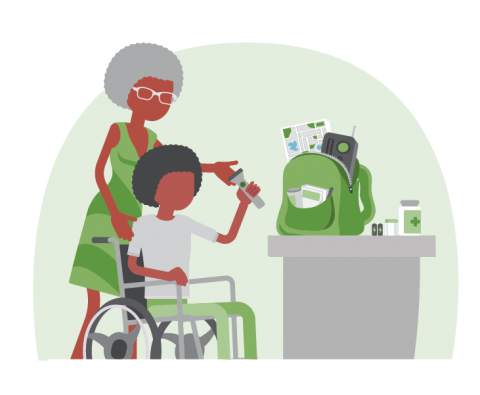Get Informed
Make a Plan
Build a Kit
People Experiencing Extreme Heat
Associated Content
Disability intersects every demographic group—there are people with disabilities of all ages, races, sex or national origin. And, disabilities can impact a person in a variety of ways—both visible and invisible. For people with disabilities and their families, it is important to consider individual circumstances and needs to effectively prepare for emergencies and disasters.
Get Informed
- Know what disasters could affect your area, which ones could call for an evacuation and when to shelter in place.
- Keep a NOAA Weather Radio tuned to your local emergency station and monitor TV and radio. Follow mobile alerts and warnings about severe weather in your area.
- Download the FEMA App and get weather alerts from the National Weather Service for up to five different locations anywhere in the United States.
Make a Plan
In the event of a disaster could you make it on your own for several days? After a disaster you may not have access to a medical facility or even a drugstore. It’s crucial to plan for your daily needs and know what you would do if they become limited or unavailable. Additional planning steps include:

- Create a support network of people who can help you in a disaster. Keep a contact list in a watertight container in your emergency kit or on your electronic devices.
- Inform your support network where you keep your emergency supplies. You may want to consider giving a trusted member a key to your house or apartment.
- Plan ahead for accessible transportation that you may need for evacuation or getting around during or after disaster. Check with local transit providers as well as with your emergency management agency to identify appropriate accessible options.
- Many city and county emergency management agencies maintain voluntary registries for people with disabilities to self-identify in order to receive targeted assistance during emergencies and disasters. Contact your local emergency management office to find out more.
- If you are on dialysis or other life-sustaining medical treatment know the location and availability of more than one facility that can help you.
- If you use medical equipment in your home that requires electricity, talk to your doctor or health care provider about what you may be able to do to keep it running during a power outage. You can also ask your power provider to put you on a list for priority power restoration.
- About half of all Americans take a prescription medicine every day. An emergency can make it difficult for them to refill their prescription or to find an open pharmacy. Organize and protect your prescriptions, over-the-counter drugs, and vitamins to prepare for an emergency.
- Wear medical alert tags or bracelets. Also add pertinent medical information to your electronic devices.
- If you have a communication disability consider carrying printed cards or storing information on your devices to inform first responders and others how to communicate with you.
- If you use assistive technologies, plan how you will evacuate with the devices or how you will replace equipment if lost or destroyed.
- Locate and access your electronic health records from a variety of sources by using the U.S. Department of Health and Human Services' online tool.
- Plan for children and adults who may have difficulty in unfamiliar or chaotic environments. Consider your service or support animal or pets and plan for food, water and supplies. If you need to evacuate, you’ll need to know whether your shelter allows pets or not, since some shelters only allow service or support animals.
- Keep a list of the nearest medical facilities, local hospitals and nearest accessible transportation.
Get Your Benefits Electronically
A disaster can disrupt mail service for days or weeks. If you depend on Social Security or other regular benefits, switching to electronic payments is an easy way to protect yourself financially before disaster strikes. It also eliminates the risk of stolen checks. The U.S. Department of the Treasury recommends two safer ways to get federal benefits:
- Direct deposit to a checking or savings account. If you get federal benefits you can sign up by calling 800-333-1795 or sign up online.
- The Direct Express® prepaid debit card is designed as a safe and easy alternative to paper checks. Call toll-free at 877-212-9991 or sign up online.
Build a Kit
In addition to having your basic survival supplies, an emergency kit should have items to meet your individual needs in various emergencies. Consider the items you use every day and which ones you may need to add to your kit.
Tips for Medications
- Talk to your doctor or pharmacist about how you can create an emergency supply of medicines.
- Keep a list of your prescription medicines. Include information about your diagnosis, dosage, frequency, medical supply needs and allergies.
- Store extra nonprescription drugs, like pain and fever relievers, antihistamines and antidiarrheal medicines.
- Have a cooler and chemical ice packs available to chill medicines that need to be refrigerated.
Tips for People Who are Deaf or Hard of Hearing
- Weather radio (with text display and a flashing alert)
- Extra hearing-aid batteries
- Pen and paper (in case you have to communicate with someone who does not know sign language)
- Battery operated lantern to enable communication by sign language or lip reading, especially when the electricity is out and it’s dark.
Tips for People Who are Blind or Have Low Vision
- Mark emergency supplies with Braille labels or large print. Keep a list of your emergency supplies and where you bought them on a portable flash drive or make an audio file that is kept in a safe place where you can access it.
- Keep communication devices for your particular needs, such as a Braille or deaf-blind communications device as part of your emergency supply kit.
Tips for People with Speech Disability
- If you use an augmentative communications device or other assistive technologies plan how you will evacuate with the devices or how you will replace equipment if it is lost or destroyed. Keep model information and note where the equipment came from (Medicaid, Medicare, private insurance, etc.).
- Plan how you will communicate with others if your equipment is not working, including laminated cards with phrases and/or pictogram.
Individuals with Intellectual or Developmental Disabilities
- Keep handheld electronic devices charged and loaded with videos and activities.
- Purchase spare chargers for electronic devices and keep them charged.
- Include sheets and twine or a small pop-up tent (to decrease visual stimulation in a busy room or to provide instant privacy).
- Consider a pair of noise-canceling headphones to decrease auditory stimuli.
- Have comfort snacks available.
Tips for People with a Mobility Disability
- If you use a power wheelchair have a lightweight manual chair available as a backup if possible.
- Show others how to assemble, disassemble and operate your wheelchair.
- Purchase an extra battery for a power wheelchair or other battery-operated medical or assistive technology devices. If you can't purchase an extra battery, find out what agencies, organizations or local charitable groups can help you buy one. Keep extra batteries charged at all times.
- Consider keeping a patch kit or can of sealant for flat tires and/or extra inner tube if wheelchair or scooter is not puncture proof.
- Keep an extra mobility device such as a cane or walker if you use one.
- Keep a portable air pump for wheelchair tires.
- If you use a seat cushion to protect your skin or maintain your balance and you must evacuate, consider keeping an extra cushion on hand.
- Communicate with neighbors who can assist you if you need to evacuate the building.
Tips for Individuals with Alzheimer’s and Related Dementia
- Do not leave the person alone. Even those who aren’t prone to wandering away may do so in unfamiliar environments or situations.
- If evacuating, help manage the change in environment by bringing a pillow and blanket or other comforting items they can hold onto.
- When at a shelter, try to stay away from exits and choose a quiet corner.
- If there is an episode of agitation, respond to the emotions being expressed. For example, say “You’re frightened and want to go home. It’s ok. I’m right here with you.”
Additional Items
- Several days supply of prescription medicines
- A list of all medications, dosage and any allergies
- Extra eyeglasses, contacts, hearing aids and batteries
- A backup supply of oxygen
- A list of the style and serial number of medical devices (include special instructions for operating your equipment if needed)
- Copies of insurance and Medicare cards
- Contact information for doctors, relatives or friends who should be notified if you are hurt
- Pet food, extra water, collar with ID tag, medical records and other supplies for your service or support animal
People Experiencing Extreme Heat
People with disabilities, access and functional needs, and older adults may be at increased risk to extreme heat. For example:
- People with spinal cord injuries are at higher risk during extreme heat because they may not be able to cool their body through sweating.
- People with severe mental health conditions, including schizophrenia, are at risk because their medications may interfere with the body’s ability to cool itself.
- People with cognitive, intellectual or developmental disabilities, including Alzheimer’s disease and dementia, are at risk because they may have trouble understanding and explaining how the heat affects them. This could prevent them from taking protective actions. It’s important to know that a person’s ability to perceive and communicate physical discomfort may vary with the stage of dementia or disease.
It is important to plan ahead, take precautions, have support, and be aware of the symptoms of heat exposure. Keep these tips in mind during extreme heat:
- If you have a support network - caregivers, family and friends – ask them to help monitor and address your heat-related needs; have them check in with you regularly to ensure you are safe and healthy.
- Read the side effects of medications and talk with your doctor about how heat exposure will interact with them.
- Take a cool shower, bath or sponge bath to cool the body if you are experiencing heat exhaustion or heat stroke.
- Ask your local energy utility for priority access in the event of power loss because power restoration is life-sustaining for someone in the home.
- Monitor your local weather and emergency information alerts.
- Have a plan that includes shade, hydration, sun protection, and limiting exposure time if you’re going to be outdoors.
- Identify possible locations with air-conditioning and ensure needed accommodations ahead of time. This could include someone in your support network with air conditioning.
- Coordinate accessible transportation to/from cooling options.
- People with medical needs who can’t be accommodated at conventional cooling options may have to contact local hospitals or nursing homes to create contingency plans if they can’t stay at home.
Associated Content
- Tips for People with Disabilities Graphics
- Preparing Makes Sense For People With Disabilities
- People with Disabilities Bookmarks (Front and Back)
- Preparing with Disabilities Social Media Toolkit
- Emergency Communication Plan (PDF)
- Transit Commuter Emergency Communication Plan (PDF)
Videos (with open captions and ASL)
Personal Disaster Preparedness
- I Use a Wheelchair
- I am Hard of Hearing
- I am Blind
- What to Know if You Live with a Disability (:19)
- What to Know if You Live with a Disability (1:14)
We Prepare Everyday


